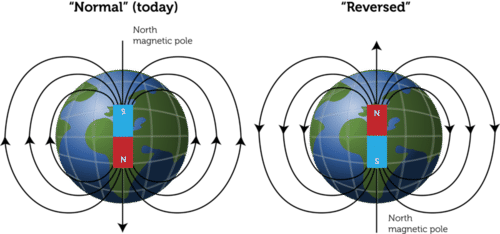For many years, scientists have been studying the Earth’s magnetic field and how it is constantly changing. One of the most interesting phenomena is magnetic reversal, which occurs when the Earth’s magnetic north and south poles switch places. While magnetic reversals are a natural occurrence and happen every few hundred thousand years, there is some speculation that we may currently be in the middle of one. But is this really the case?
First, let’s understand what magnetic reversal is and how it happens. The Earth’s magnetic field is generated by the movement of molten iron in the planet’s core. The magnetic field is not static and can change in strength and direction over time. When the magnetic field reverses, the north and south poles switch places, causing the compass needle to point south instead of north.
Scientists have found evidence of magnetic reversals in the geological record, where the orientation of magnetic minerals in rocks can be used to determine the polarity of the Earth’s magnetic field at the time the rocks were formed. These records show that magnetic reversals have occurred many times throughout Earth’s history, with the most recent one occurring around 780,000 years ago.
Now, let’s look at the evidence that suggests we may be in the middle of a magnetic reversal. One piece of evidence comes from the European Space Agency’s Swarm mission, which launched three satellites in 2013 to study the Earth’s magnetic field. The mission has found that the Earth’s magnetic field is weakening at a rate of about 5% per decade, which is faster than previously thought. This weakening could be a sign that a magnetic reversal is imminent.
Another piece of evidence comes from the South Atlantic Anomaly, an area in the Earth’s magnetic field where it is particularly weak. Satellites passing through this region can experience technical malfunctions due to the increased exposure to radiation from space. The South Atlantic Anomaly has been growing in size and strength in recent years, which could be a sign that the Earth’s magnetic field is undergoing significant changes.
However, while these pieces of evidence may suggest that a magnetic reversal is underway, it is important to note that the process is not a sudden event. Magnetic reversals take thousands of years to complete, and there is no guarantee that the current changes in the Earth’s magnetic field will result in a full reversal. In fact, some scientists believe that the changes we are seeing now are just part of a natural fluctuation in the magnetic field, rather than the start of a reversal.

So, what would happen if a magnetic reversal did occur? While it is unlikely to cause any immediate harm to humans, it could have some significant effects on our technology and the environment. The Earth’s magnetic field helps protect us from cosmic rays and other harmful radiation from space, so a weakening or reversal could lead to increased radiation exposure. It could also cause disruptions to satellite and communication systems, as well as animal migration patterns that rely on the Earth’s magnetic field for navigation.
In conclusion, while there is some evidence to suggest that we may be in the middle of a magnetic reversal, it is important to remember that this process takes thousands of years to complete and is not a sudden event. The changes we are seeing now could simply be part of a natural fluctuation in the magnetic field, rather than the start of a reversal. However, it is still important for scientists to continue monitoring the Earth’s magnetic field and studying how it changes over time, as understanding this phenomenon can provide insights into the Earth’s geologic history and the effects of space weather on our planet.
![]()


